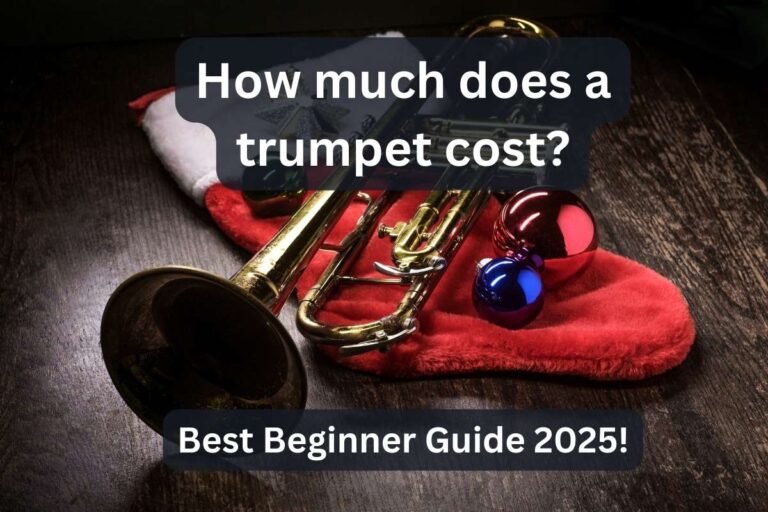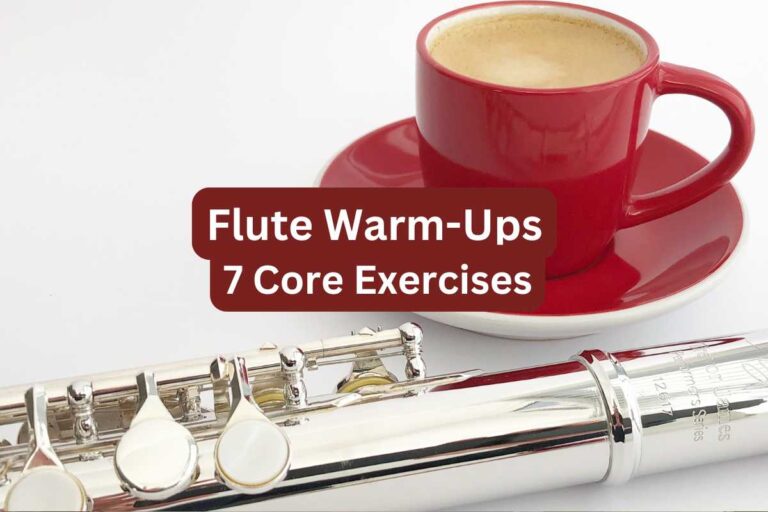Trumpet Range Exercises PDF — 5 Top Options Every Trumpist Should Practice Today
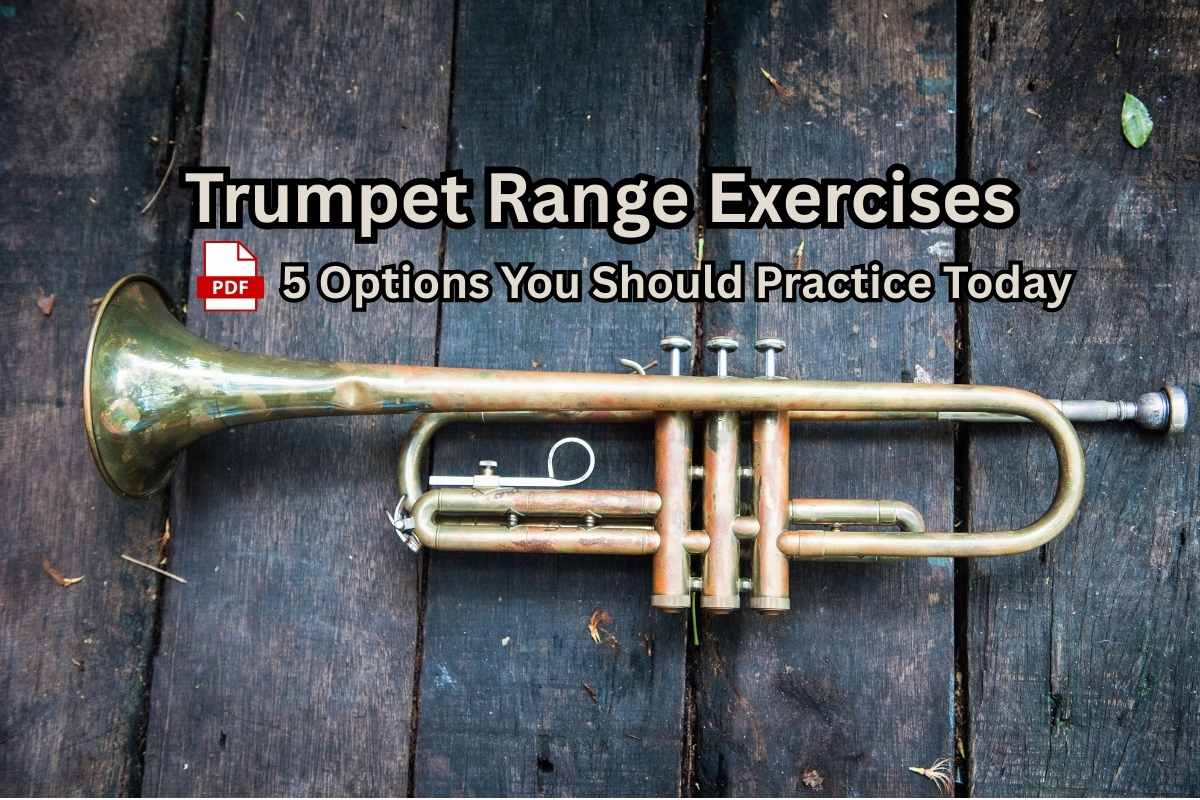
Stuck in a range rut? Boost your high notes with these five solid Trumpet Range Exercises! Three of ’em are actual drills. The other two are popular trumpet tunes that naturally stretch your range.
This guide gives you 5 go-to PDFs every player should keep in their case. These are killer drills and tunes that push your range without you even noticing. Grab one and let’s go blow.
Still learning your horn? Check this “Best B Flat Trumpet Fingering Chart PDF + 12 Notes“!
What are the Best Trumpet Range Exercises?
Wanna play higher? Cleaner? Longer? You need Trumpet Range Exercises that actually deliver. Not just lip flutters and baby slurs — I’m talking range-boosting, lip-stretching, breath-challenging drills.
Trumpet Range Exercises aren’t magic. They’re just tools — and like any tool, they only work if you use them right. If the exercise sounds good but feels tense, STOP! Range grows with clean tone and relaxed pressure — NEVER with brute force.
A solid range exercise should challenge — but not destroy you. It’s about control first, then power. If you’re blasting high notes till your chops give out, you’re not building range — you’re just shredding muscles.
When choosing the proper exercise for you, ask yourself:
- What’s my current range?
- Where do I feel weak — tone, slotting, breath, endurance?
- Do I need power or finesse?
- Am I recovering from lip fatigue or building new range?
It’s not about what’s trendy or who played it first. It’s about what your playing needs right now.
Use that info to guide your daily work. Some days it’s a stretch session. Some days, it’s maintenance mode. And that’s cool. Range isn’t built in one week — it’s built in dozens of consistent ones.
Also, check out these “5 Trumpet Tone Exercises PDF — Free Sheet Music + Pro Tips For Routines“!
These five exercises below (all in handy PDFs) help you get from high C to double C. They work if you stick with them.
Trumpet Range Exercises — # 1
Build power and stretch your range one step at a time! “Range Exercise #1” uses long tones and gradual range extension. Each line includes a four-note phrase, with the 4th note held long with a fermata (hold as long as you can), followed by a 5-second rest.
It’s just 4/4 time, slow tempo, and steady air. You’ll see “decrescendo,” meaning your sound should fade out slowly. After a rest, go on to the next pair of notes.
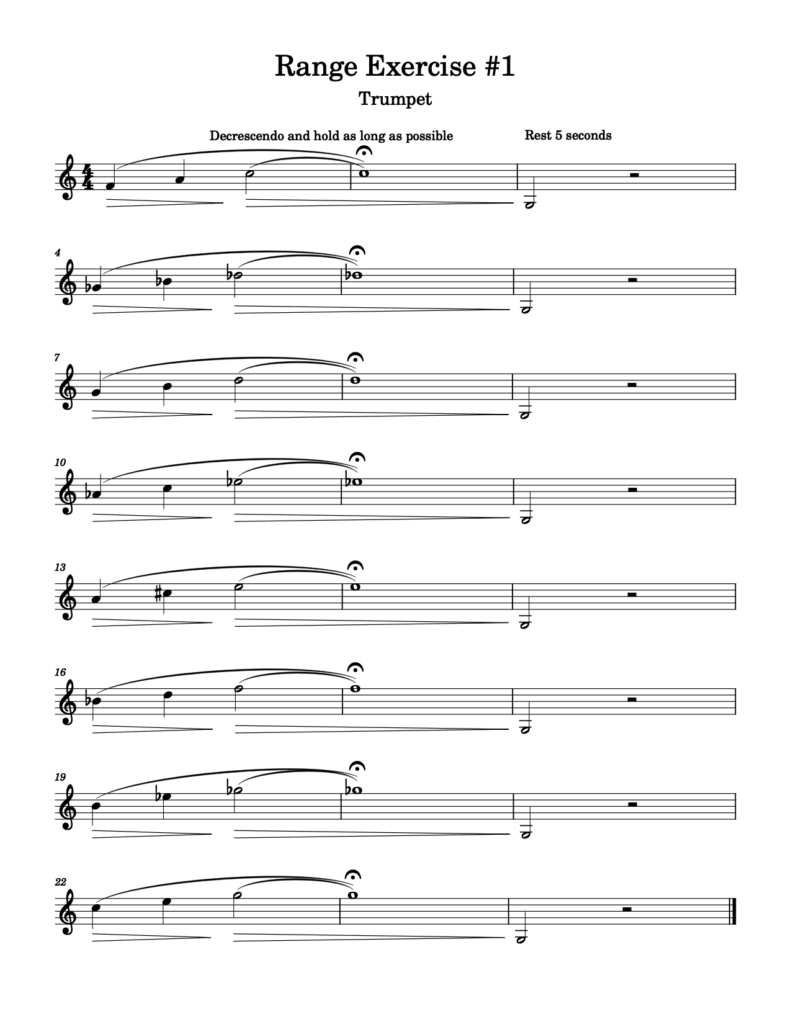
“Range Exercise #1” is one of the simplest but strongest trumpet range exercises. It works well for all levels, helps build safe habits, and keeps your tone strong and smooth.
Trumpet Range Exercises — # 2
“Range Exercise 2” is a scale-based trumpet drill that helps expand your playable range. It’s all about moving step-by-step (chromatically) up and down through the trumpet’s register.
This exercise is in treble clef, in C major with no sharps or flats in the key signature, but it travels through accidentals across 8 full lines. It uses only quarter notes and standard time (4/4) throughout. Keep the tempo steady and don’t rush — around 60–80 BPM. Focus more on tone than speed.
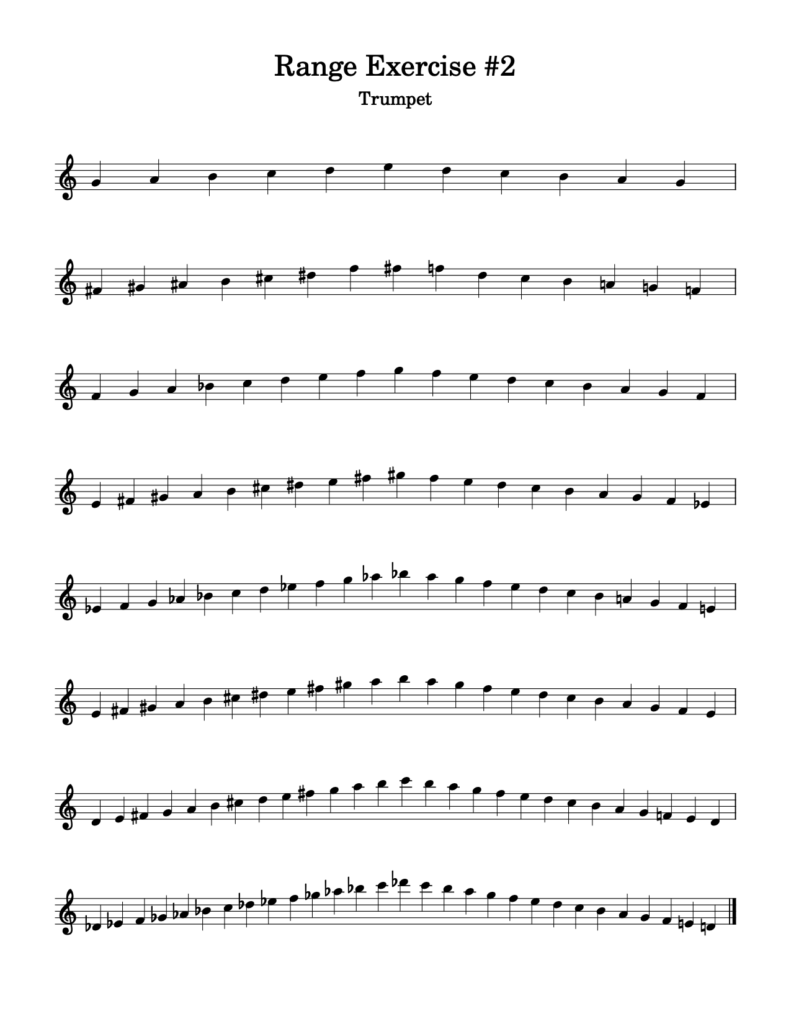
“Range Exercise 2” for trumpet stretches your playable notes. IT starts in the middle register (G) and chromatically pushes both higher and lower. You’ll hit almost every possible note on the trumpet — natural, sharp, and flat.
Important reminder: After each line, take the horn off your face. Give your lips a break before the next stretch.
Trumpet Range Exercises — # 3
The “Range Exercise 3” consists of sustained, paired whole notes with long rest measures between each pair. Every note gets two beats — so you’ll hold it out and breathe deeply! This intentional structure gives your embouchure time to recover between playing segments.
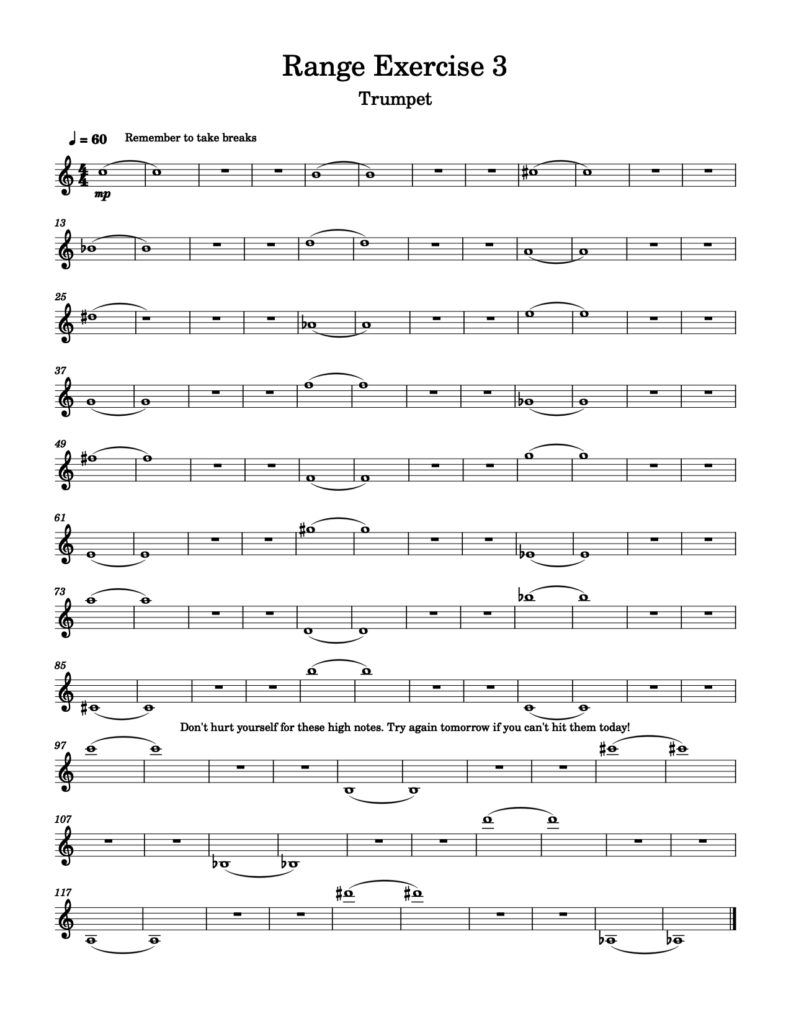
Range Exercise 3 is 128 measures long in a 4/4 time signature with a moderate tempo marking of 60 beats per minute. It is at a comfortable mezzo-piano (mp) dynamic level, which means play it softly, not loud, not weak — just gentle.
After the last high note, keep going into pedal tones. They help relax your lips. Then take a 5–10 minute break. Do lip slurs, warm down, and return fresh the next day!
Trumpet Range Exercises — Nessun Dorma Beginners Arrangement for Trumpet
“Nessun Dorma Beginners Arrangement” is a melodic piece you can use as a trumpet range exercise. It helps trumpeters build confidence in the upper register.
This piece is written in E♭ major — bright, clear. It’s in 4/4 time (four beats in each measure), and it flows at a slow tempo with 60 BPM. That slower pace gives you time to focus on air, tone, and your high notes.

Use this piece to train your chops, not test them. Let the melody guide your range development. You don’t need to master the high notes right away. Take it easy and work your way up to the notes you need to reach.
Instead of just blowing harder to play high drill notes, you’re learning to control air, aperture, and embouchure through a real melody. The exercise uses a famous opera aria to naturally guide your playing into higher notes.
The music is full of useful markings. There are slurs (for smooth air), accents (for strong emotion), and dynamics like “mf” (mezzo forte) and “ff” (fortissimo). Near the end, you’ll see “rit.”, which means slow down. That gives the ending a big, dramatic feel — just like the opera.
Trumpet Range Exercises — Once Upon A Time In The West for Trumpet
The “Once Upon A Time In The West” beginner trumpet arrangement is another way to build range without pressure. This piece is calm, steady, and full of gentle high notes that help your chops grow over time. I personally love this one because it sounds beautiful and never feels forced.
The melody (Ennio Morricone’s iconic score) flows, making playing high notes feel natural. You’re not jumping into the upper range — you’re gliding into it. And this isn’t a loud piece. It’s lyrical — that’s why I like it!

It begins in C major (open and clear), moves into C♭ major (softens the tone), and finally lands in G major (brighter, more focused). The time signature is 4/4, and the tempo is marked quarter note = 110. That’s a smooth walking pace — not too fast or slow. The notes start low and go all the way to high G and A.
Most lines move by steps or small intervals. There are lots of long tones, slurs, and expressive phrases. You’ll also see ties and a few dotted rhythms — these help teach control and sustain.
Trumpet Range Exercises — Tips
Most players don’t get stuck because the exercises are bad. They get stuck because they don’t know how to practice them right. They go too hard, too fast, or just repeat the same mistakes till their lips give out.
Rest longer if you feel tired or stiff after some of the high notes. You’ll make MORE progress with smart breaks rather than with tired playing.
Pay attention to your air. Think about using fast, steady air, not hard, just focused. Your aperture (the opening between your lips) should stay relaxed — but not floppy. Your tongue needs to stay in the right spot (like saying “tah” or “tee”). Get that trio right — air, aperture, and tongue — and your sound will feel easier and clearer!
Also, don’t press your trumpet into your face. It won’t help you play higher — it just hurts and messes up your embouchure. The power should come from your breath, not pressure.
Try to keep each note as steady as possible. Don’t let the pitch slide around or get shaky. You want it centered and clean. That’s how you build strong, reliable high notes.
Conclusion — Trumpet Range Exercises
Building trumpet range isn’t some secret trick — it’s a grind. A slow, focused, everyday kind of grind. And here’s the truth — if you show up, you grow.
The right Trumpet Range Exercises, used the right way, will get you there. Focus on clean tone, smart rest, solid breath, and steady effort.
And don’t rush the high notes. Let them come to you — by building control, not pressure.
So stay in it. Be patient. Blow smart.

